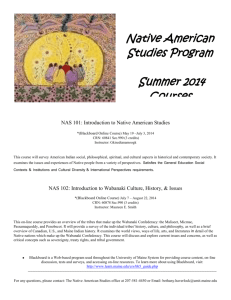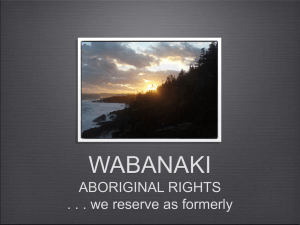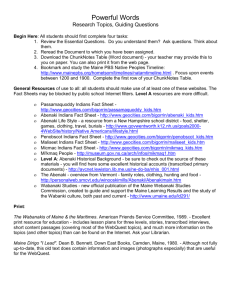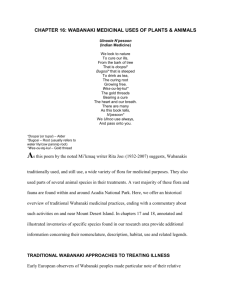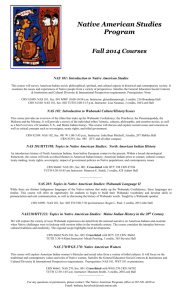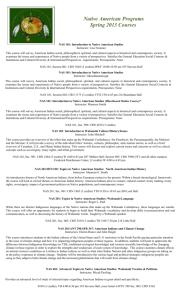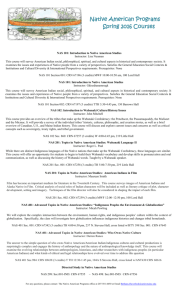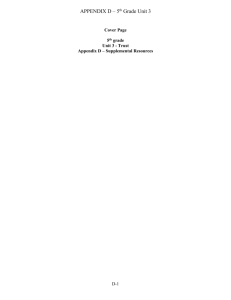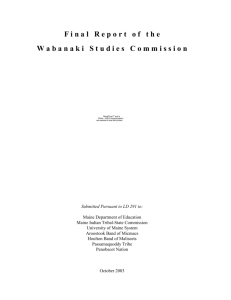SketchbookNWP
advertisement
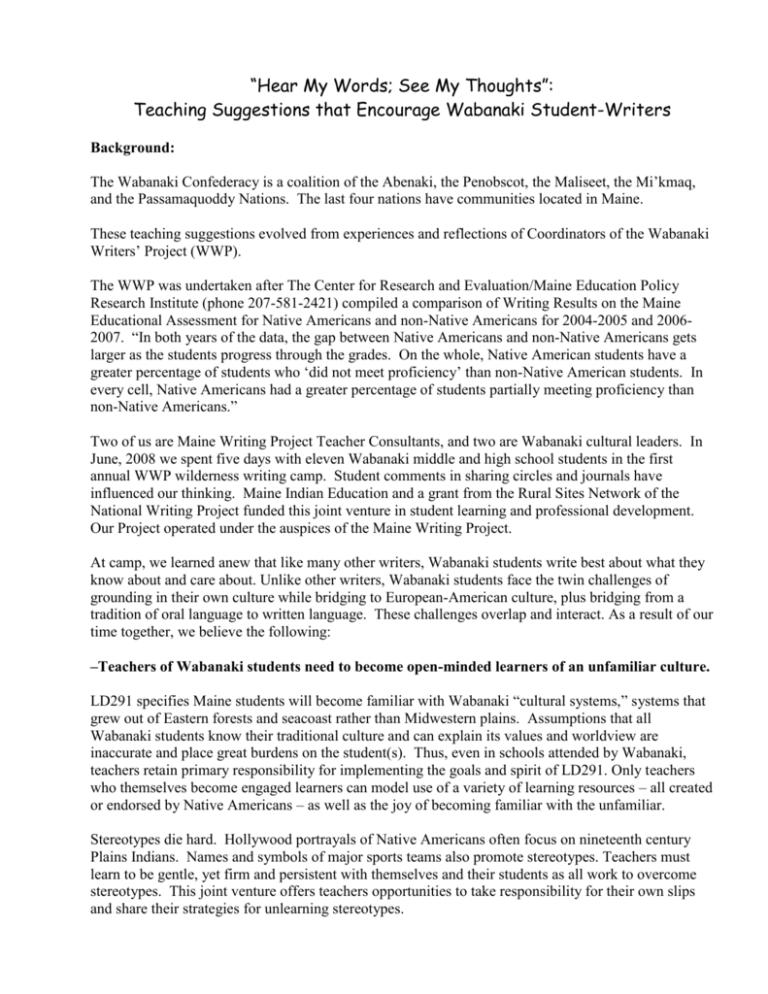
“Hear My Words; See My Thoughts”: Teaching Suggestions that Encourage Wabanaki Student-Writers Background: The Wabanaki Confederacy is a coalition of the Abenaki, the Penobscot, the Maliseet, the Mi’kmaq, and the Passamaquoddy Nations. The last four nations have communities located in Maine. These teaching suggestions evolved from experiences and reflections of Coordinators of the Wabanaki Writers’ Project (WWP). The WWP was undertaken after The Center for Research and Evaluation/Maine Education Policy Research Institute (phone 207-581-2421) compiled a comparison of Writing Results on the Maine Educational Assessment for Native Americans and non-Native Americans for 2004-2005 and 20062007. “In both years of the data, the gap between Native Americans and non-Native Americans gets larger as the students progress through the grades. On the whole, Native American students have a greater percentage of students who ‘did not meet proficiency’ than non-Native American students. In every cell, Native Americans had a greater percentage of students partially meeting proficiency than non-Native Americans.” Two of us are Maine Writing Project Teacher Consultants, and two are Wabanaki cultural leaders. In June, 2008 we spent five days with eleven Wabanaki middle and high school students in the first annual WWP wilderness writing camp. Student comments in sharing circles and journals have influenced our thinking. Maine Indian Education and a grant from the Rural Sites Network of the National Writing Project funded this joint venture in student learning and professional development. Our Project operated under the auspices of the Maine Writing Project. At camp, we learned anew that like many other writers, Wabanaki students write best about what they know about and care about. Unlike other writers, Wabanaki students face the twin challenges of grounding in their own culture while bridging to European-American culture, plus bridging from a tradition of oral language to written language. These challenges overlap and interact. As a result of our time together, we believe the following: –Teachers of Wabanaki students need to become open-minded learners of an unfamiliar culture. LD291 specifies Maine students will become familiar with Wabanaki “cultural systems,” systems that grew out of Eastern forests and seacoast rather than Midwestern plains. Assumptions that all Wabanaki students know their traditional culture and can explain its values and worldview are inaccurate and place great burdens on the student(s). Thus, even in schools attended by Wabanaki, teachers retain primary responsibility for implementing the goals and spirit of LD291. Only teachers who themselves become engaged learners can model use of a variety of learning resources – all created or endorsed by Native Americans – as well as the joy of becoming familiar with the unfamiliar. Stereotypes die hard. Hollywood portrayals of Native Americans often focus on nineteenth century Plains Indians. Names and symbols of major sports teams also promote stereotypes. Teachers must learn to be gentle, yet firm and persistent with themselves and their students as all work to overcome stereotypes. This joint venture offers teachers opportunities to take responsibility for their own slips and share their strategies for unlearning stereotypes. Most media and textbook portrayals of Columbus, Thanksgiving, Pocahontas, and all events since first contact are presented from a European-American perspective (views from the boat, not from the shore). For starters, teachers need to learn the Wabanaki worldview of these events. Wabanaki culture promotes respectful relationship with Nature, not remaking nature to serve human purposes. The Wabanaki language is a language of connecting, not of identifying and differentiating. At camp, Roger Paul taught, “To European-Americans ‘tree, rock, and dirt’ mean only the physical phenomenon, but Wabanaki see trees as brothers, rocks as the ancient ones (grandfathers and grandmothers), and dirt, which provides life through the soil (or earth) as Mother.” Wabanaki culture views education as experiencing Nature, Self, and Community, not as an isolated journey into books and writing. In a Wabanaki context, each space has a story – the shadows on the hills, the way the clouds gather, the wind moving across water. In a Wabanaki Council, people often avoid eye contact to better focus on the content of the message. At camp, writing conferences often took place outdoors with teacher and student both looking out, not at each other. One Mi’kmaq girl found her writing tree and reported inspiration/strength whenever she composed on her laptop with her back against that tree. Perhaps in another sitting, the tree would tell her its story. When participants recorded their present moment thoughts of Self and surrounding context, powerful pieces emerged. In these instances, they were living a guiding statement from Vicky Akins – “Let your writing come from the inside” (rather than striving to contrive an end product). The priority in Wabanaki culture is first person plural, not first person singular. As a sense of community emerged among students from different tribes, their conversations about writing became more inclusive, more diverse – richer. Wabanaki culture values variety, not one right way, nor one correct opinion. Students honored all pieces with positive, emotional responses. “Wow, that was scary!” “You must have been . . .” They approached honest feedback with reluctance and concern for the writer’s feelings and perspective. Wabanaki culture values reciprocity. Student-writers expected an intensity of attention and emotional investment from responders (Coordinators as well as peers) that matched their creative efforts. –Teachers of Wabanaki students need to encourage them to write from a Wabanaki perspective/context. A number of our Wabanaki students attend schools whose curriculum do not include historical and contemporary “views from the shore” and ignore an evolving body of Native American literature. In this environment, everything these students have believed in since birth can seem minimalized. They begin to doubt their own abilities. They then discount the idea that they themselves have stories worth telling. Adults from their own culture and teachers who are actively exploring the view from the shore offer the best hope for persuading them they do have something to say, and perhaps to write. When Allen Sockabasin, a published Passamaquoddy author, spent an evening at camp sharing life experiences that led him to become a writer, he conveyed how essential it is for young writers to connect to their Wabanaki heritage: “If you can't put your arms around our people, you will not be able to write.” Teachers must realize that many Wabanaki students need to develop anchor lines to their own culture. Outside of school, they need to listen to Wabanaki storytellers. They need time with Wabanaki cultural leaders to learn more of their own culture and to chat about their evolving ideas. In school, they need to learn the stories of Native Americans who became writers and read Wabanaki literature with their classmates. In our wilderness setting, as cultural leaders developed students’ awareness of Wabanaki culture, students became more grounded, more in touch with themselves and our emerging community, and more empowered as writers. Ours was indeed a cultural camp and a writing camp. Teachers can coach Wabanaki student-writers to tailor their writing to different audiences. With a Wabanaki audience, often only a precise word from their own language works. Teachers have to be sensitive to these situations and willing to invite the writer to enlighten them on the significance of the word. With an audience of “others,” teachers can show how parenthetical expressions are used. Example: Paumpagauset (spiritual being/our teacher/Great Mother) of Ketouh (ocean/water without end as natural phenomenon). Joseph Bruchac’s stories model this convention and are “good reads.” -Teachers of Wabanaki students need to teach strategies for writing by embedding them in oral language. Only in reflection did we as coordinators realize the students’ need for writing strategies was independent of students’ talent. “Hear my words; see my thoughts” is the keystone of the arch that connects oral tradition to writing strategies for idea formation, natural revision, and proofreading. When we looked back, we recalled, participants often voicing debilitating doubts about their story ideas: “Is there a story here? Will it be boring?” Most needed the reassurance gkisedtanamoogk provided, “What you told me is story; you just need to put it down.” In our opinion, a caring, culturally sensitive adult volunteer can perform this function. When we looked back, we remembered students often sitting alone, waging silent struggles with writer’s block. They didn’t brainstorm, tinker with a web, make a sketch, or free write. In sharing circles they did not mention ever having tried idea formation strategies such as revisiting a location to note its details or interviewing a key player in a scene they sought to portray. They seldom sought to connect with another writer to try out story ideas or rehearse orally a challenging section of their piece. When we set up response pairs, we noted, “It’s good” or “You should have . . .” constituted most feedback. The idea of a responder asking open-ended questions was novel. Peter Elbow’s “pointing” technique (underlining words and phrases that resonate; squiggle those that don’t) was unknown. Students didn’t read their work aloud to others or ask others to read it to them. Lacking meaningful responses, our writers revised by tinkering with word choices and restructuring sentences. They didn’t write from “hot spots” or approach the same story with a fresh piece of paper or a new screen. In sharing circles, many students commented that in school they had had limited, if any experiences in reading their writing aloud. They expressed a common opinion that giving their piece to the teacher to read silently and comment upon in the margins didn’t engage them in conveying their message. Reading aloud engages students in a process of natural revision. At camp, students read their pieces aloud to Coordinators. (We believe a culturally sensitive adult volunteer also could perform this function.) They chose whether to read their work aloud in pairs, in small groups, or to the whole community. After – and while giving voice to their writing, students readily engaged in revision, striving to get their message right. Students were reluctant to engage in proofreading. When they did, it was an isolated, silent activity, punctuated by grimaces. They did not read text aloud in order to notice the presence or absence of punctuation signaling pauses that change meaning. They did not take advantage of the mutual strengths of proofreading partners. During camp, our observations of student behavior around proofreading and their comments left no doubt that in most of their prior experiences focus had been given to conventions and not to the composing process. Wabanaki students need the approach to conventions of a writing workshop: Before coaching even touches upon conventions, students need to know they have been heard, their content has been received. They need to know discussion of their errors will be prioritized in respect to how critical they are to meaning. They need to know help with proofreading will be provided prior to publishing. Oral language plays a key role in each strategy for composing, revising, and proofreading. When writing strategies are taught in a framework that consistently embeds voice in these strategies, Wabanaki students become more grounded in their culture’s oral tradition and empowered in their writing processes. In circles and journals, students shared their need for teachers in all content areas not just to give directions, but to model aloud processes for recalling relevant underlying concepts and evaluating which strategies might work best. In all written assignments, efforts like these are essential if Wabanaki students are to realize more success –Teachers who write, who model the composing processes of a writer, who build community within their classrooms, who listen and learn to listen more astutely to the voices of their Wabanaki students demonstrate “responsive practice.” They are likely to see more success in their students’ writing assignments and assessments. Hear their thoughts, and you will see their words. Wabanaki Writers’ Project Coordinators - Victoria Akins, Penobscot, teacher at Indian Island School, MWP Teacher-Consultant; - Paul Frost, UM instructor COEHD, former teacher (grades 3 – 8), MWP Teacher-Consultant - gkisedtanamoogk, Wampanoag, UM instructor in Native American Studies - Roger Paul, Maliseet and Passamaquoddy, language teacher at Indian Island School, Cultural Consultant Penobscot Nation Wabanaki Writers’ Project Resource List This resource list provides a starting point for acquiring information about the Wabanaki and relevant concepts from other Native American sources. It offers a variety of genres in the hope that each user can find a comfortable entry point. Sources of particular interest to English teachers at all levels are marked with asterisks. Websites of General Interest Maine Department of Education Learning Results. Maine Native/Wabanaki Studies. <http://maine.gov/education/lres/ss/studies.html> Wabanaki Tribal Websites; Information about LD 291; Lesson Plans; Wabanaki History, Culture, Language Study, Oral History, Legends, videos, and links to many other valuable websites. If you were to only choose one resource, this would be the one. *NCTE Beliefs about the Teaching of Writing (November 2004) <www.ncte.org/prog/writing/research/118876.htm> *Oyate (a Native organization working to see that our lives and histories are portrayed honestly) 2702 Mathews Street, Berkeley, CA 94702 (510) 848-6700 <http:www.oyate.org> Catalog features recommended books by grade level. Website offers critiques of selected books that have been popular in public schools. Wabanaki Studies: Lessons and Resources for Middle School and High School. Elizabeth SkyMcLivain. <http://www.leasttern.com/Wabanaki/index.html> This site was developed by a teacher to support teachers with resources and lessons plans in the implementation of LD 291. Great site for information, inspiration, and ideas – it is the essence of what LD 291 is all about. Wabanaki Studies, University of Maine. Orono, ME. <http://www.umaine.edu/LD291> Site specializes in background material and lesson plans for Maine teachers working to implement LD291 by providing viable instruction in the culture and history of the Wabanaki. Windows on Maine. <http://windowsonmaine.library.umaine.edu/index.aspx> This pilot program delivers streamlined video programs and clips on a vast array of topics, including many offerings on the Wabanaki. Nonfiction *Unlearning “Indian” Stereotypes: A Teaching Unit for Elementary Teachers and Children’s Librarians. New York, NY: The Racism and Sexism Resource Center for Education, A Division of the Council on Interracial Books for Children, 1981. *Brooks, Lisa. The Common Pot: Indigenous Writing and the Reconstruction of Native Space in the Northeast. University Of Minnesota Press, 2008. *Bruchac, Joseph. Survival This Way: Interviews with American Indian Poets. Tucson, AZ: The University of Arizona Press, 1987. Calloway, Colin G. Dawnland Encounters: Indians and Europeans in Northern New England. Hanover and London: University Press of New England, 1991. Conkling, Robert, et al. The Wabanakis of Maine & the Maritimes. Philadelphia, PA: American Friends Service Committee, 1989. DeLoria, Vine Jr. Custer Died For Your Sins: An Indian Manifesto. Norman, OK: University of Oklahoma Press, 1969. Eckstorm, Fanny Hardy. Indian Place Names of the Penobscot Valley and the Maine Coast. Maine Studies No. 55. Orono, ME: University of Maine at Orono, 1974. *Long, Cindy. “Save the Indian, Save the Child.” NEAtoday 27.3 (2008): 38-41. McBride, Bunny. Molly Spotted Elk: A Penobscot in Paris. Norman, OK: University of Oklahoma Press, 1995. *Mihesuah, Devon A. American Indians: Stereotypes & Realities. Atlanta, GA, Clarity Press, Inc. 1996. Nicolar, Joseph, Charles Norman Shay, and Annette Kolodny. The Life and Traditions of the Red Man: Reading Line: A Rediscovered Treasure of Native American Literature (Original Bangor, ME: C.H. Glass and Company, 1893). Duke University Press, 2007. *Ortiz, Simon J. Speaking for the Generations: Native Writers on Writing. Tucson, AZ: The University of Arizona Press, 1998. Prins, Harald E. L. “The Children of Gluskap: Wabanaki Indians on the Eve of European Invasion,” in American Beginnings: Exploration, Culture and Cartography in the Land of Norumbega Lincoln, NB: University of Nebraska Press, 1994. Ranco, Fred and Tara Marvel. Muskrat Stew and Other Tales of a Penobscot Life: The Life Story of Fred Ranco. Occasional Publications of the Maine Folklife Center, No. 2, University of Maine, Orono, 2007. Sockabasin, Allen J. An Upriver Passamaquoddy. Gardiner, ME: Tilbury House Publishers, 2007. Swisher, Karen, and John Tippeconnic III. Next Steps: Research and Practice to Advance Indian Education. Charleston, WV: Clearinghouse on Rural Education and Small Schools, 1999. especially Chapter 6: Cajete, Gregory. “The Native American Learner and Bicultural Science Education.” *Zimet, Abby. “Lost in Translation: Can the Penobscot language be brought back from the brink of extinction?” Down East 54.3 (2008): 70-73, 98-100. Oral Traditions and Fiction *Alexie, Sherman. The Absolutely True Diary of a Part-Time Indian. New York: Hachette Book Group USA, 2007. *Alexie, Sherman. Smoke Signals. New York: Hyperion, 1998. *Bruchac, Joseph. Tell Me a Tale: A Book about Storytelling. San Diego: Harcourt Brace & Co., 1997. See also *The Heart of a Chief and other works by this author. Bruchac, Margaret M. “Earthshapers and Placemakers: Algonkian Indian Stories and the Landscape,” pp. 56-80 in H. Martin Wobst and Claire Smith, eds. Indigenous Archaeologies: Decolonizing Theory and Practice. London: Routledge Press, 2005. *Bruchac, Margaret. Malian's Song. Middlebury, VT: Vermont Folklife Center, 2006. *Savageau, Cheryl. Muskrat Will Be Swimming. Gardner, ME: Tilbury House Publishers, 2006. *Sockabasin, Allen. Thanks to the Animals. Gardner, ME: Tilbury House Publishers, 2005. Poetry *Green, Rayna, ed. That’s What She Said: Contemporary Poetry and Fiction by Native American Women. Bloomington, IN: Indiana University Press, 1984. *Joe, Rita. Poems of Rita Joe. VT: Abenaki Press, 1978. *Joe, Rita. Song of Eskasoni: More Poems of Rita Joe. CA: Women’s Press, 1989. *Kenny, Maurice. Carving Hawk: New and Selected Poems. New York: White Pine Press, 2002. *Niatum, Duane, ed. Carriers of the Dream Wheel: Contemporary Native American Poetry. New York: Harper & Row Publishers, 1981. *Niatum, Duanne, ed. Harper’s Anthology of 20th Century Native American Poetry. New York: HarperCollins Publishers, 1988. *Savageau, Cheryl. Mother/Land. Cambridge, UK: Salt Publishing, 2006. Video Eyre, Chris. A Thousand Roads. Washington, DC: National Museum of the American Indian, Seven Arrows/Telenova Production, 2005. 500 Nations: Kevin Costner Explores America’s Indian Heritage. Dir. Jack Leustig. Warner Bros. 1995 (sold by Amazon). Savagery and the American Indian; Part 1: “Wilderness” Part 2: “Civilization” (1991). VHS ISBN 978-0-7365-1578-8 sold by Films Media Group <http://ffh.films.com/> Also located in UM Native American Studies resource room. Suzuki Speaks 46-minute DVD winner of Gemini Award 2004 for Best Science, Technology, Nature, Environment, or Adventure Documentary. Avanti Pictures <http://www.avantipics.com/films/suzuki_speaks/> Internet Aroostook Band of Micmacs. Cultural Community Education Center, Presque Isle, ME. <http://www.micmac-nsn.gov/html/museum.html> Houlton Band of Maliseet Indians. Littleton, ME. <http://www.maliseets.com/> Native IQ Test: Test Your Native IQ: How much do you know about Native American history and contemporary life. Understanding Prejudice website: Exercises and Demonstrations <http://www.understandingprejudice.org/nativeiq/ > Passamaquoddy Tribe at Indian Township, ME. <http://www.passamaquoddy.com/index.htm> Passamaquoddy Tribe at Pleasant Point, ME. <http://www.wabanaki.com/index.html> Penobscot Indian Nation. Indian Island, ME. <http://www.penobscotnation.org/> Robert Abbe Museum. Bar Harbor, ME. <http://www.abbemuseum.org/index.php> CD/Tape/Transcript *Alternative Radio speeches by Native Americans available as transcripts (email or hard copy) as tapes (prior to September 2007) and as CDs (after September 2007). Examples: Russell Means, leader of American Indian Movement; Winona LaDuke, Green Party Vice Presidential candidate Alternative Radio. <http://www.alternativeradio.org/available_formats.shtml>
